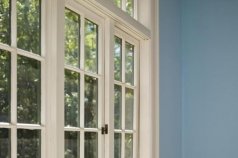Some window frames are more energy efficient than others. Below is a breakdown of the various types of frames.
Aluminum and Metal
Frames made from aluminum or metal tend to be strong and require little to no maintenance. Frames made from these materials conduct heat rapidly, and as a result, they provide poor insulation. Adding a plastic strip between the inner and outer frame and sash creates a thermal break and fixes this problem.
Composite
Composite frames are made from wood particles such as particleboard and laminated strand lumber. These frames are stable and have the same structural and thermal properties as those made from conventional wood; however, they also have a better resistance to moisture and rot.
Fiberglass
Frames made from fiberglass are dimensionally stable and provide better insulation than those made from wood or uninsulated vinyl because they have air cavities that prevent air from escaping.
Vinyl
Vinyl frames are made from polyvinyl chloride and ultraviolet light stabilizers meant to protect against sunlight that can break down material. These frames tend to be low-maintenance because they don't require painting and are moisture resistant. This is because the vacant cavities in these barriers prevent air from escaping, which makes them better choices than standard vinyl and wood frames.
Wood
Frames made from conventional wood expand and contract depending on weather conditions. Wood frames require a lot of maintenance which can be somewhat reduced by installing aluminum or vinyl cladding.
Reasons to Repair
Fixing a faulty window frame as soon as an issue is noticed will reduce the chances of needing to replace it. Window frames should be repaired to prevent rot or shrinkage. Additionally, cracked wood frames may lead to exposure to weather conditions. Window frames should also be maintained to keep a home secure. Drafty window frames should be repaired to keep a home more eco-friendly and reduce energy costs. Finally, if a home is outfitted with high-maintenance window frames such as wood, it may be worth replacing these items to reduce costs over time.
Common Repairs
Below is a list of common problems and fixes for window frames.
- Broken Frame: A broken window frame may be patched with the same material the frame was made from. However, many wood frames can rot beyond the point of repair and will likely need to be removed and replaced.
- Broken Sash Interlock: A broken sash interlock greatly increases the chance of leaks and drafts. Glazing these sashes can prevent water from entering a home and causing rot and mold.
- Broken/Leaking Nail Fin: Nail fins are strips used to attach a window frame to a stud opening. Sometimes, these fins may break or corrode and need replacement. The area on the frame may need to be repaired, or the frame may need to be replaced.
- Leaking Windows: Over time, screws in a frame may corrode and may require replacement. Rot could also ruin the rest of the frame, and it would need to be replaced. Alarm sensors are often placed on window frames. Sometimes, these sensors can damage a window frame. Fixing this issue typically involves removing the alarm sensor and fixing the damaged area.
When to Replace Frames
If a window frame has been seriously damaged by water or rot, it may be time to call in a professional to replace it. Many homeowners choose to replace their old conventional wood frames with a low-maintenance solution such as metal or vinyl frames. Some people choose to replace their window frames to lower their energy costs and make their homes more eco-friendly.
Was this page helpful?
Thank you for submitting your feedback.












